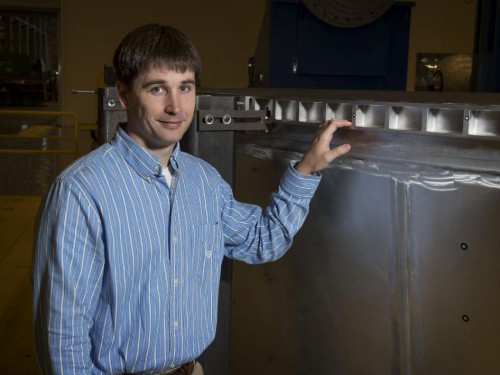
Photo Credit: NASA/MSFC/Fred Deaton)
HUNTSVILLE, Ala — When a scholarship to the University of Alabama in Huntsville opened the door to an engineering degree for Jonathon Walden, it opened another door for him as well: a job at NASA’s Marshall Space Flight Center in Huntsville, Ala., designing a crucial piece of flight hardware for the Space Launch System (SLS), NASA’s new heavy-lift rocket.
Walden, a native of Decatur, Ala., is the lead designer for the Multi-Purpose Crew Vehicle Stage Adapter. It will attach NASA’s Orion spacecraft to a United Launch Alliance Delta IV rocket for Exploration Flight Test-1 in 2014. The same adapter technology later will connect Orion to SLS, which is managed and in development at Marshall and will be capable of sending Orion into deep space.
“I really didn’t know if I was even going to go to college after I graduated high school, but when I received a scholarship to UAH, I decided I wanted to go into engineering,” said Walden, who is currently working on his master’s degree in aerospace engineering at his alma mater. “Engineering seemed like a natural choice for me, as my grandfather helped design the Patriot missile. I wanted to follow in his footsteps.”
“It’s an exciting field of work,” he added. “Especially getting to see my designs go from sketches to manufacturing. That’s a big deal in the design world. It’s not just ideas on paper anymore.”
And a lot of pen-to-the-paper concepts are necessary when you’re crafting twin adapters—one to use for a structural test, and the other to actually fly on Orion’s first test flight. During its initial flight, Orion will travel to an altitude of approximately 3,600 miles above Earth’s surface. By flying Orion out to those distances, NASA will be able to see how the spacecraft performs in and returns from deep space journeys. The flight test also will provide engineers with important data about the adapter’s performance before it is flown on SLS.
Walden has spent countless hours with analysts and other engineers, assessing the design of the adapter, creating models, problem solving for better configurations, reviewing data prior to machining, and overseeing each part of the manufacturing process to make sure design requirements are met at each stage.
“We just flipped the structural test adapter to drill holes in it to connect it to the Delta IV,” Walden said. “I make sure any manufacturing we do, like drilling holes and surfacing, follows the design requirements. That’s a big part of ensuring we get things right on the second adapter before it flies.”
Now that the twin adapters are going through final machining, and the Spacecraft & Payload Integration Office’s preliminary design review is underway, it’s back to the drawing board for Walden, who’s preparing for the SLS program critical design review, scheduled for 2015. The prototype adapter’s structural test is planned for later this fall.
“With every concept, every drawing, we are one step closer to being ready to fly in 2014, and 2017,” Walden said. “It’s an incredible feeling to know my work is a part of getting us there.”
For more information on the adapter ring work at Marshall, visit: http://www.nasa.gov/exploration/systems/sls/ringflip.html
For more information about NASA’s Space Launch System, visit: http://www.nasa.gov/exploration/systems/sls/
Want to keep up-to-date with all things space? Be sure to “Like” AmericaSpace on Facebook and follow us on Twitter: @AmericaSpace



